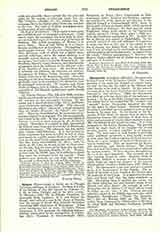

Synaus, (SYNAITANSIS), a titular see in Phrygia Pacatiana, suffragan of Laodicea. Nothing is known of the history of this city located by Ptolemy (V, ii, 22) in Great Phrygia, and in the sixth century by Hierocles (668, 13), in Phrygia Pacatiana, its metropolis being Laodicea. It is now Semao (or Simao), chief town of a caza in the vilayet of Broussa near the springs of Semav Sou, formerly Macestus; containing 5000 inhabitants all Mussulmans. It has a few inscriptions but no ruins. Le Quien (Oriens christianus, I, 813) mentions the following bishops: Arabius, represented by his metropolitan at Chalcedon (451); Pronimus, at Constantinople (553); Stephanus, at Niewa (787); Constantine at Constantinople (869); Sisinnius and Eusebius, supporters respectively of St. Ignatius and Photius, at the Photian Council of Constantinople (879); Isaac, at the Council of Constantinople (1351), which approved the doctrines of Palamas. To these may be added Stephanus, whose name occurs in the inscription (eighth century?) “Corp. inser. graec.”, 8666 perhaps the Stephanus mentioned in 787. In 1394 the See of Synaus was united to Philadelphia. In the seventh century it was still suffragan of Laodicea; it seems also that at this time it was united to the See of Ancyra, now Kilisse Keui. In the ninth century it was attached to the metropolis of Hierapolis and remained so till its disappearance, as appears from the Greek “Notitiae episcopatuum”; however, the Roman Curia‘s official list of titular sees makes it suffragan of Laodicea.
S. PATRIDES

